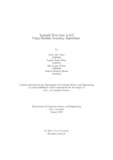| dc.contributor.advisor | Chakrabarty, Amitabha | |
| dc.contributor.author | Arko, Aritro Roy | |
| dc.contributor.author | Khan, Saadat Hasan | |
| dc.contributor.author | Preety, A a Anjum | |
| dc.contributor.author | Biswas, Mehrab Hossain | |
| dc.date.accessioned | 2019-10-02T08:34:38Z | |
| dc.date.available | 2019-10-02T08:34:38Z | |
| dc.date.copyright | 2019 | |
| dc.date.issued | 2019-08 | |
| dc.identifier.other | ID 15201020 | |
| dc.identifier.other | ID 15201013 | |
| dc.identifier.other | ID 15301046 | |
| dc.identifier.other | ID 15201008 | |
| dc.identifier.uri | http://hdl.handle.net/10361/12776 | |
| dc.description | This thesis is submitted in partial fulfillment of the requirements for the degree of Bachelor of Science in Computer Science, 2019. | en_US |
| dc.description | Cataloged from PDF version of thesis. | |
| dc.description | Includes bibliographical references (pages 43-45). | |
| dc.description.abstract | Internet of Things (IoT) is growing as one of the fastest developing technologies
around the world. With IPv6 settling down, people have a lot of addressing spaces
left that even allows sensors to communicate with each other while collecting data,
leaving alone cars that communicate while travelling. IoT (Internet of Things) has
changed how humans, machines and devices communicate with one another. However,
with its growth, a very alarming topic is the security and privacy issues that
are encountered regularly. As many devices exchange their data through internet,
there is a high possibility that a device may be attacked with a malicious packet of
data. In such cases, the security of the network of communication should be strong
enough to identify malicious data. In other words, it is very important to create an
intrusion detection system for the network. In our research, we propose a comparison
between di erent machine learning algorithms that can be used to identify any
malicious or anomalous data and provide the best algorithm for two data-sets. One
dataset is on the environmental characteristics collected from sensors and another
one is network dataset. The rst data-set is developed from the data exchanged
between the sensors in an IoT environment and the second dataset is UNSW-NB15
data which is available online. | en_US |
| dc.description.statementofresponsibility | Aritro Roy Arko | |
| dc.description.statementofresponsibility | Saadat Hasan Khan | |
| dc.description.statementofresponsibility | A a Anjum Preety | |
| dc.description.statementofresponsibility | Mehrab Hossain Biswas | |
| dc.format.extent | 45 pages | |
| dc.language.iso | en | en_US |
| dc.publisher | Brac University | en_US |
| dc.rights | Brac University theses are protected by copyright. They may be viewed from this source for any purpose, but reproduction or distribution in any format is prohibited without written permission. | |
| dc.subject | IoT (Internet of Things) | en_US |
| dc.subject | Anomaly detection | en_US |
| dc.subject | Intrusion detection | en_US |
| dc.subject | Machine learning algorithms | en_US |
| dc.subject | Sensor data | en_US |
| dc.subject | Network data | en_US |
| dc.subject | UNSW-NB15 | en_US |
| dc.subject.lcsh | Machine learning | |
| dc.subject.lcsh | Internet of things | |
| dc.subject.lcsh | Intrusion detection systems (Computer security) | |
| dc.subject.lcsh | Anomaly detection (Computer security) | |
| dc.title | Anomaly detection In IoT using machine learning algorithms | en_US |
| dc.type | Thesis | en_US |
| dc.contributor.department | Department of Computer Science and Engineering, Brac University | |
| dc.description.degree | B.Sc in Computer Science | |

